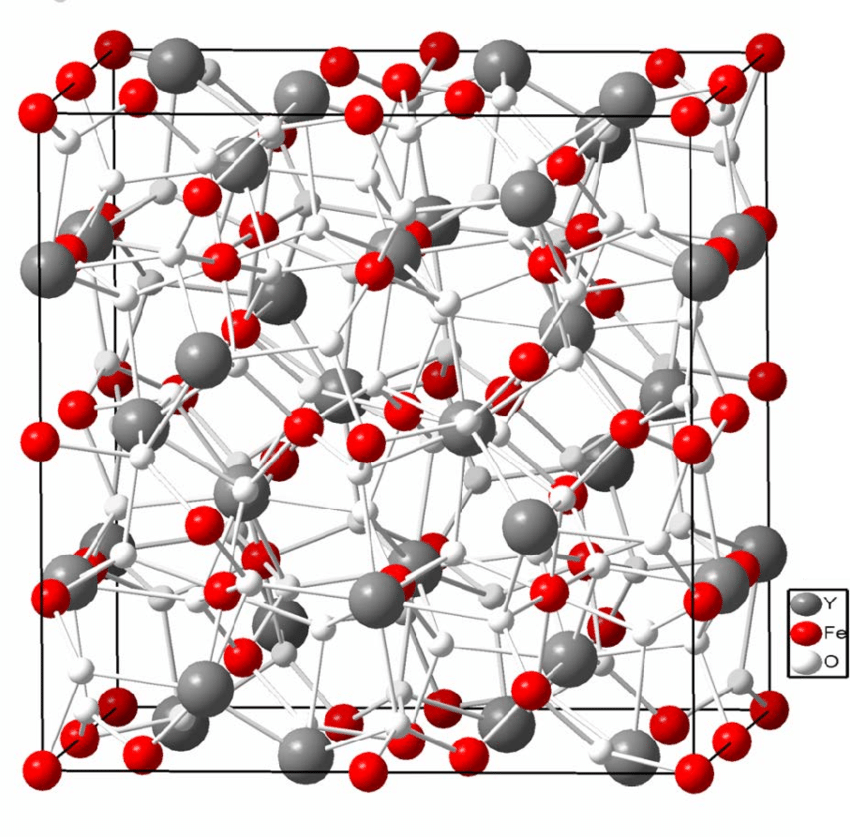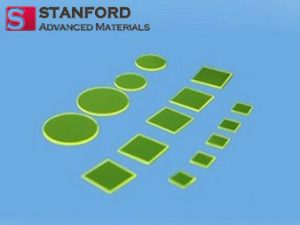Introduction
Yttrium Iron Garnet (YIG), with its enigmatic presence in the domain of material science, has been silently powering some of the most advanced technologies of our time. Discovered in the mid-20th century, this ferrimagnetic material has evolved far beyond its initial applications, proving itself as a backbone in the realms of microwave and optical technologies. Its unique properties, including a high Curie temperature, impressive magnetic and optical behavior, and excellent electrical insulation, make YIG an indispensable material in the development of devices where precision is paramount. This article embarks on a journey to unravel the mysteries of YIG, from its fundamental properties and crystal structure to its synthesis techniques, comparative advantages, and its expansive role in pushing the boundaries of modern technology.
1: Yttrium Iron Garnet (YIG) Unveiled
1.1: Fundamental Properties
At the heart of YIG’s appeal in technological applications is its ferrimagnetic nature, characterized by a high Curie temperature of approximately 560 K (287°C). This property ensures that YIG maintains its magnetic capabilities even at elevated temperatures, making it ideal for devices operating across a broad range of thermal conditions. Furthermore, YIG exhibits a low damping factor, which minimizes energy loss during signal processing, a critical factor for the efficiency of microwave electronics.
YIG is also celebrated for its significant magneto-optical effects. These effects allow for the manipulation of light based on the material’s magnetic state, a capability that has been ingeniously harnessed in the creation of optical isolators and circulators. Such components are crucial in optical communication systems, where they mitigate back-reflection and interference, thus preserving signal fidelity.
1.2: Crystal Structure and Composition
The crystal structure of YIG is a marvel of nature’s design, featuring a cubic system with a garnet-type arrangement. This intricate structure is composed of yttrium, iron, and oxygen ions arranged in a manner that facilitates YIG’s exceptional properties. Yttrium ions occupy dodecahedral sites, iron ions are positioned in both octahedral and tetrahedral sites, and oxygen ions form tetrahedra around these metals. This specific configuration is instrumental in fostering YIG’s ferrimagnetic behavior, which in turn, is a cornerstone of its optical and magnetic phenomena.

2: Synthesis and Fabrication Techniques
The production of high-quality Yttrium Iron Garnet (YIG) materials is pivotal for their performance in advanced technological applications. The synthesis and fabrication of YIG involve a variety of methods, each with its own set of advantages and challenges. Among these methods, the solid-state reaction technique is traditional, involving the firing of a stoichiometric mixture of yttrium, iron, and oxygen at high temperatures. This method, while cost-effective, requires precise control over temperature and atmospheric conditions to produce pure YIG crystals.
Another sophisticated approach is the liquid phase epitaxy (LPE), favored for crafting thin YIG films with exceptional uniformity and quality. LPE facilitates the growth of YIG on substrates, making it an ideal technique for applications in integrated optical devices and microwave circuits. However, the complexity and cost of equipment necessary for LPE can be a barrier to its widespread use.
The choice of synthesis method directly impacts the magnetic and optical properties of the resulting YIG materials. Advances in fabrication technologies continue to push the boundaries of what is possible with YIG, optimizing its characteristics for specific applications and opening new avenues for its use in cutting-edge technology.
3: Comparative Analysis with Other Materials
Yttrium Iron Garnet (YIG) stands out among ferrimagnetic materials for its unique combination of high Curie temperature, low damping factor, and significant magneto-optical effects. When compared to other materials such as ferrites and garnets, YIG offers a superior balance of magnetic and optical properties, making it the material of choice for a wide range of applications.
However, the decision to use YIG over other materials is often driven by specific application requirements. For instance, in applications where lower-frequency magnetic properties are sufficient, other ferrites might be preferred due to their lower cost. Conversely, YIG’s exceptional performance at high frequencies and its ability to maintain stability under thermal stress make it indispensable in advanced microwave and optical devices.
This comparative analysis highlights YIG’s distinct advantages while acknowledging situations where alternative materials might be more appropriate. Understanding these distinctions is crucial for researchers and engineers in selecting the right material for their specific technological challenges.
4: Broad Spectrum Applications of YIG
4.1: Established Applications
Microwave Electronics: YIG’s role extends beyond filters and oscillators. It is crucial in the development of YIG-based tunable band-pass filters, phase shifters, and limiters. These components are integral to enhancing the performance and adaptability of radar and communication systems, where precise control over signal propagation and interference is necessary.

Optical Technologies: Beyond isolators and circulators, YIG finds applications in magneto-optical modulators and switches. These devices utilize YIG’s magneto-optical effects to modulate light, enabling advanced control in optical communication and processing systems. Such applications underscore YIG’s contribution to increasing the efficiency and capacity of fiber optic networks.
4.2: Emerging Technologies
Spintronics: YIG’s magnetic properties are being harnessed in the realm of spintronics, where the spin of electrons, rather than their charge, is used for information processing. YIG films can act as efficient spin conductors, offering a pathway to ultra-low power consumption electronics and non-volatile memory technologies.
Quantum Computing: In quantum computing, YIG is explored as a material for magnon-based quantum bits (qubits). Its low damping factor allows for the coherent coupling of magnons – quanta of spin waves – with photons, paving the way for quantum information processing and magnon spintronics.
Biomedical Engineering: YIG nanoparticles are investigated for their potential in magnetic hyperthermia therapy, a cancer treatment method that uses localized heat generated by magnetic materials under an alternating magnetic field. Their unique magnetic properties allow for targeted therapy with minimal impact on surrounding healthy tissues.
Energy Technologies: YIG’s ferrimagnetic properties are also being exploited in energy harvesting and storage technologies. Magnetoelastic sensors based on YIG can convert mechanical energy into electrical energy, offering new solutions for wireless sensor networks and battery-less technologies.
Environmental Sensing: The sensitivity of YIG to external magnetic fields is utilized in high-precision magnetometers and environmental sensors. These devices can detect minute changes in magnetic fields, contributing to geological surveys, space exploration, and climate monitoring.
5: The Impact of Impurities and Doping
The properties of Yttrium Iron Garnet (YIG) can be finely tuned through the introduction of impurities or doping elements. This manipulation allows for the customization of YIG’s magnetic and optical characteristics to meet specific application needs. For instance, doping with non-magnetic ions can adjust the material’s magneto-optical response, enhancing its utility in optical devices. Conversely, the introduction of certain impurities might be used to tailor the material’s magnetic damping for specific microwave applications.
6: Environmental and Economic Implications
The production and application of Yttrium Iron Garnet (YIG) also carry environmental and economic implications. While the synthesis of YIG requires high temperatures and precise conditions, ongoing research aims to make the process more energy-efficient and environmentally friendly. Economically, the cost of raw materials and the complexity of fabrication techniques influence the adoption of YIG in commercial applications. Nonetheless, its unparalleled performance and the demand for advanced microwave and optical devices continue to justify the investment in YIG technology.
Conclusion
Yttrium Iron Garnet (YIG) emerges as a critical material in the advancement of modern technology, from enhancing the capabilities of microwave and optical devices to opening new frontiers in emerging technological fields. Its unique properties, enabled by its distinct crystal structure and tunable through sophisticated synthesis and doping techniques, make YIG an invaluable asset in the pursuit of technological innovation. As the applications of YIG continue to expand, its role in shaping future technologies becomes ever more evident, underscoring the importance of continued research and development in this versatile material. The exploration of YIG not only highlights its current significance but also illuminates the path for future advancements that leverage its unique properties for groundbreaking applications.
The synthesis and manipulation of Yttrium Iron Garnet stand as a testament to the ingenuity and persistence of scientists and engineers striving to harness the full potential of materials science. As we delve deeper into the molecular intricacies of YIG and its interactions with other elements, we unlock new possibilities that extend beyond traditional applications. The adaptability of YIG to meet diverse technological needs, from the core of quantum computing to the frontiers of biomedical research, represents a beacon of innovation.
Moreover, the journey of YIG from a material of interest to a cornerstone of advanced technology underscores the critical role of interdisciplinary research in material science. The collaboration between physicists, chemists, engineers, and technologists fosters an environment where the boundaries of what is possible are continually expanded. YIG’s story is a reminder of the transformative power of materials when their secrets are fully understood and harnessed.
In conclusion, Yttrium Iron Garnet is more than just a material; it is a key player in the ongoing technological revolution, enabling advancements that were once deemed impossible. Its versatility, enhanced by scientific breakthroughs in synthesis and application, ensures its continued relevance in advancing modern technology. As we look to the future, the potential of YIG and materials like it to inspire innovation and drive progress is limitless. The exploration of YIG’s properties and applications is not just an academic pursuit but a gateway to future technological marvels that will continue to shape our world.
Click to Inquiry High Quality Yttrium Iron Garnet Crystal Substrate





